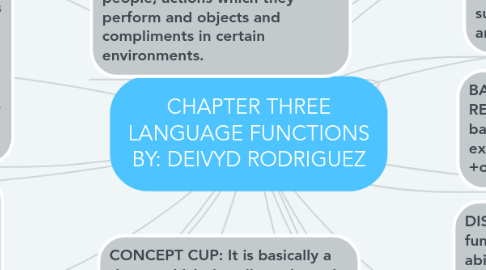CHAPTER THREE LANGUAGE FUNCTIONS BY: DEIVYD RODRIGUEZ
Deivyd Rodriguezにより

1. SEMANTIC RELATIONSHIPS: The relationship between words and people, actions which they perform and objects and compliments in certain environments.
2. CONCEPT CUP: It is basically a theory which describes, through the use of the word “cup”, how children gradually go from producing relatively basic sentences to producing comprehensively complete sentences over time. For example, going from sentences like “me cup” to “I would like to attend the World Cup net year in Russia but I am not sure if I will have saved enough money.
3. SEMANTICITY: When concepts overlap so as to get children to gradually make more and more complex sentences. It is also known as semantic complexity.
4. FLEXIBILITY: It refers to a set of language functions which enable the speaker to be more flexible when appropriate.
5. PRODUCTIVITY: It is when a learner has acquired or learned a set of expanded language functions and reaches a level of maximum productivity – languagewise.
6. REDUNDANCY: Another expanded language function which refers to when a person’s productivity and flexibility are hindered due to a lack of displacement and semanticity.
7. EXPANDED LANGUAGE FUNCTIONS: It is a language process which involves increasing the level of complexity of sentences.
8. CONCRETE COGNITION: It is a stage in language learning which is represented by neuro-semantic processes of overlapping and layering of patterns and concepts to increasing the level of complexity of sentences. Concrete cognition is developed by extending the meanings through who, what, where, when, why, and how of basic semantic relationships.
9. SPEECH ACTS: Also known as conversational language functions which are used to perform a variety of functions within a conversation.
10. EXPANDED SPEECH ACTS: It refers to the advanced use of sophisticated language to have complex conversations and debates. It goes beyond the simple back and forth statements.
11. PREDICATION: It is the ability language learner acquires to link previously stated information to forthcoming information in a logical and sequential manner.
12. AUDITORY PROPOSITION: It is when a language learner has acquired the ability to connect a third idea to two previously stated and possibly independent ideas. These three arguments correlate to form a proposition.
13. AGENCY: The relationship between a person and others in his/her surroundings. It is also regarded as a fundamental function of early language acquisition. As of late, human agency has played a key role in certain human affairs such as transforming social structures.
14. AGENT: A person who is central to an idea or thought in relationship to others. The agent can be either the subject or the object of a sentence.
15. BASIC SEMANTIC RELATIONSHIP: One of the most basic semantic relationships that exist is that of agent + action +object.
16. SOCIO-COGNITIVE DEVELOPMENT: It refers to the child’s evolution in regards to ideas and notions about interactions between the self and society in general.
17. EXTENSION: The child is a supplement to his/her parents and the environment.
18. GROUNDED: It is basically a limitation of movement on behalf of the child which is limited to certain surfaces such as mom’s arms, the bed and the couch.
19. DISPLACEMENT: It is a language function which deals with the ability to refer to others and their actions which extend beyond the here and now. It is a sort of mental time travel if you will.
20. OVERLAPPING: It refers to the act of combining past and present experiences acquired from continued input that the child receives or has received in order to enhance language development. It is akin to stacking one piece of knowledge on top of another.
21. LAYERING: It refers to the inherit ability a child has to decipher past and present experiences in order to use the language in a very efficient way.
22. LEXICON: It is a general consensus of what a word means within a certain society.


